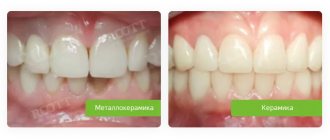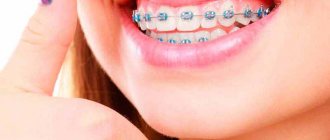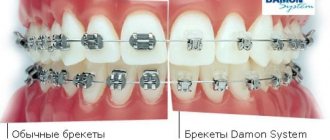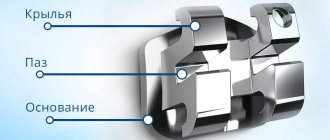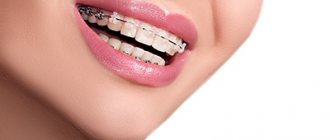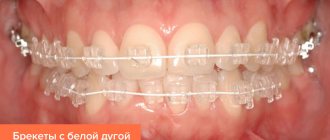Braces are divided into types according to different parameters: functionality, installation principle, material, etc. Usually the doctor invites the patient to choose an orthodontic design based on medical indications and his financial capabilities. How to make the right choice? Let's find out what types of braces there are and how they differ from each other.
In this article
- What types of braces are there?
- Metal braces
- Plastic braces
- Ceramic braces
- Sapphire braces
- Types of bracket systems according to the method of fixation
- Types of braces according to the location of fixation
- Other types of braces
- Which braces to choose
A brace system is an orthodontic structure that is used to correct bite pathologies. Today, this is one of the most effective ways to straighten teeth, with which you can cure almost any disease associated with improper jaw development and dental growth.
Braces consist of many parts, the main ones being the locks and the arch. The first ones are attached to the enamel using a special dental glue. Throughout the entire time you wear orthodontic braces, the locks remain in the places to which they were glued. A metal arc is passed through them. It puts pressure on the jaw and dentition, which helps align the teeth.
Braces are installed for a period of several months to 2-3 years, depending on the pathology of the bite. Every 1-3 months, the patient comes to see the orthodontist to tighten the arch and increase the pressure on the teeth. This continues until they take the correct position.
The duration of orthodontic treatment is determined not only by medical indications, but also by the type of braces. Factors such as comfort, aesthetics, safety, etc. also depend on the type of system. There are many options for installing orthodontic structures. Often, after an examination, the doctor invites the patient to choose the type of braces himself, based on his financial capabilities, lifestyle, profession, etc.
We will help you make the right choice and describe all the types of orthodontic brackets used today in modern dentistry.
What types of braces are there?
Bracket systems are classified according to several bases:
- by material: metal, plastic, ceramics and sapphire;
- by type of fixation: ligature and non-ligature (self-ligating);
- by place of installation: lingual and vestibular.
Each bracket system has its own distinctive properties, advantages and disadvantages. We will describe each type separately.
Metal braces
Metal brackets for correcting bites are the most common type of braces, which appeared more than 70 years ago. Over time, the design has been modified and modernized, but the principle of its structure has remained the same. Metal braces systems consist entirely of metal, mainly medical steel. This material is very durable, so you can achieve the fastest results with it.
It also has other advantages:
- can correct almost any malocclusion pathology;
- are installed both on the outside and on the inside of the teeth;
- are included in the middle price category (more expensive than plastic, but cheaper than ceramics).
Metal braces also have disadvantages. Among them:
- require adaptation, during which they may rub the oral mucosa;
- affect the patient’s diction;
- low aesthetic properties;
- Not suitable for people with individual metal intolerance.
Often such braces are rejected because they are unsightly. However, in the absence of contraindications, they can be placed on the back side of the dentition.
Metal braces are not only steel, but also titanium. The latter are lighter and more durable, and also have high functionality. In addition, they are biocompatible and therefore do not cause allergies. They are installed for allergy sufferers and patients with gastrointestinal problems. Prices for titanium bracket systems are slightly higher than for steel structures.
What are the benefits of early treatment?
When correcting a bite, in most cases the patient will go through a stage where his upper incisors will (temporarily) stick out forward. Such protruding teeth, especially in children, are most susceptible to injury from falls and bruises, and besides, they are not very aesthetically pleasing. Early treatment, for example, avoids this situation.
Also, early correction of the bite allows the orthodontist to positively influence the growth of the jaw, the width of the dental arches, improve the aesthetics and self-esteem of the child, and eradicate bad habits. The process of eruption of permanent teeth is also improved by creating space for them to erupt (if there is a lack of it), the total time of orthodontic treatment and its cost are reduced, and diction is improved. We hope that our article on the topic: Installation of braces reviews was useful to you!
Sources:
1. “Orthodontics. Textbook for dentists" (Kutsevlyak V.I.), 2. American Association of Orthodontists (USA), 3. National Library of Medicine (USA), 4. "Conceptual orthodontics" (Williams Stefan), 5. "Fixed orthodontic technique" (Gerasimov S.N.), 6. https://www.realself.com/.
Plastic braces
All types of braces are connected by a metal arch, due to which the correction is carried out. The design may have plastic locks, screws and other parts, but the arc will still be made of metal. Plastic braces are a good alternative to steel and titanium braces when it comes to aesthetics. However, in terms of efficiency, plastic products are much inferior to metal ones. We list the main advantages of plastic braces:
- low cost;
- stealth;
- short period of adaptation.
Typically, such systems are installed on children or patients with minor defects. However, plastic braces are not suitable for people who play sports or have severe occlusion diseases. This is due to the following disadvantages of plastic braces:
- have low strength;
- are not able to create strong pressure;
- are installed only on the outside of the teeth;
- quickly stain and darken due to eating and smoking.
Plastic braces can be single-colored or multi-colored. If desired, the orthodontist can prepare a design with locks of different colors: blue, red, purple, yellow, etc. Such brackets look unusual. As some people believe, if there is no way to hide your braces from others, make them original.
Read also
How to place veneers
The installation of veneers is performed for the purpose of aesthetic restoration of the dentition.
How long do you wear braces and what affects the timing?
When deciding on the use of orthodontic structures, patients are often interested in how long they wear braces on their teeth.
Ceramic braces
Braces are also more invisible and aesthetically pleasing if they are made of ceramic. There are many varieties of ceramic materials that differ from each other in shades. The doctor can choose a design that will completely match the natural shade of the teeth. Ceramic braces can only be noticed at close range. If you paint the metal arch white, the staples will become even less noticeable.
The main advantages of braces made from ceramics:
- high aesthetics;
- short adaptation period;
- do not injure the buccal mucosa;
- strength is higher than that of plastic.
The disadvantages of such systems include:
- difficulty in dismantling (may crack);
- darken from tobacco smoke and dyes;
- are not installed on the inside of the teeth;
- high price.
Typically, ceramic braces are chosen by people for whom it is important to hide orthodontic treatment from others.
Let's sum it up
How to choose effective braces for an adult, and which ones are best for teenagers and younger children? All these issues should be resolved together with a doctor, depending on the diagnostic results, the severity of the pathological process, the location of the problem, individual characteristics, financial capabilities and other factors. You will have to wear the arches for a long time, so it is important to carefully think through all the details of the treatment so that it does not cause discomfort.
The dental clinic installs the most popular types of structures at affordable prices. Call the phone number listed on the website or leave a request and we will contact you as soon as possible. Our specialists will help you select the appropriate orthodontic device and develop therapeutic tactics.
Sapphire braces
The sapphire bracket system is the most expensive, as it is made from artificial sapphire. This material has the highest strength. It makes it possible to produce a structure for the treatment of severe pathologies. But the main advantage of sapphire staples is invisibility. They are completely transparent, so they are practically invisible to others. If a patient orders a white arch, few will realize that he is undergoing treatment from an orthodontist. There are other advantages to such bracket systems:
- have hypoallergenic properties;
- allow you to quickly adapt;
- do not cause problems with diction;
- more resistant to dyes.
The main disadvantage of the sapphire system is its high cost. It is also impossible to install it on the inside of the dentition.
Often the patient has to choose between metal and plastic structures, which are not as expensive as ceramic and sapphire. However, the material of the staples is not the only basis on which they are classified. Let's find out what other types of braces exist.
What is dangerous about malocclusion?
When answering the question in what cases it is necessary to install braces and why this is necessary, it is worth familiarizing yourself with the consequences of ignoring the pathological process. Many people mistakenly believe that the lack of timely intervention only affects the patient’s appearance, so it is not so important whether to leave everything as is or still resort to the help of a professional orthodontist.
What will happen if you don't fix it?
What do these anomalies lead to:
- problems with the speech apparatus;
- difficulty swallowing, chewing food;
- disorders of the gastrointestinal tract;
- headaches, migraines;
- diseases of the musculoskeletal system;
- loosening and loss of incisors, canines, molars;
- frequent oral infections.
Types of bracket systems according to the method of fixation
Depending on the type of fixation, braces can be ligature or non-ligature. Ligatures are small elastic bands with which the arch is fixed to the braces. Instead of rubber bands, the orthodontist may use thin wire made of aluminum, steel or silver. Systems that use ligatures are called ligature systems.
Non-ligature or self-ligating braces are not much different from ligature braces, they just do not use this elastic band. In the groove of the structure itself there is a cover or lock, which allows you to fix the arc on the system.
Which braces are best to choose for correction? There is not much difference between them. They cope with any bite pathologies with equal efficiency. However, there are still minor differences. Ligature systems need to be tightened approximately once a month, and non-ligature systems - once every 2-3 months. If a person lives far from a dental clinic, it is better for him to install self-ligating structures. They are also suitable for those people who travel frequently and cannot come to the dentist every month.
Ligature and non-ligature braces can be plastic, metal, ceramic and sapphire. If you want to save money, but not at the expense of treatment and aesthetics, you can choose plastic ligature staples with multi-colored ligatures. Sapphire self-ligating systems will look most aesthetically pleasing.
Types of braces according to the location of fixation
Depending on the place of installation, braces are divided into vestibular and lingual. The first ones are installed on the outside of the teeth, and the second ones on the inside. Which of these two designs is better? Each system has its pros and cons.
Vestibular or external braces are inferior to lingual braces in aesthetics. But they are suitable for any malocclusion diseases. In addition, they come in metal, sapphire, plastic and ceramic, while lingual structures are made only from metal. Other advantages of external braces:
- easier to care for;
- defects are corrected faster;
- less rubbing of the oral mucosa.
The main advantage of lingual braces is their invisibility. They are chosen by people who have to constantly negotiate, speak in public, etc. They are also often played for children. The disadvantages of such systems are as follows:
- difficult to care for;
- rub the tongue;
- greatly affect diction.
Many people never get used to the fact that their tongue is constantly in contact with metal. Ulcers and wounds often appear on it, which hurt and bleed. Also, a person with lingual braces has a lisp throughout orthodontic treatment. Not everyone can cope with these problems psychologically.
If we talk about effectiveness, then with the help of lingual and vestibular braces you can achieve the same result if the treatment is modeled correctly. Installation of internal structures is a more labor-intensive process, but an experienced orthodontist will cope with this task without any complications.
Other varieties
One of the solutions to the problem of correcting malocclusion in children is the invention of colored or shaped “braces.” In fact, such systems have colored ligatures, and not the braces themselves, and in general an interesting effect is created.
Children and teenagers are often embarrassed to wear classic corrective braces, and a colored or shaped version can greatly simplify this procedure. As a result, such “braces” become a detail of the image, emphasizing individuality. In addition, the period of adaptation to wearing the structure, purely psychologically, passes in an easier form.
Curly braces
There is no point in talking about curly braces as a special type: these are ordinary systems equipped with ligatures of a unique shape. Children and teenagers prefer ligatures in the shape of stars or hearts. For parents, this often becomes the only effective way to involve the child in the treatment process, especially since sometimes it stretches over several months or longer periods.
Colored "braces"
Colored ligatures of colored “bracket systems” do not have any design features; they are designed to perform the same functions as ordinary conventional braces. The only additional role of these structures is to eliminate psychological barriers that prevent you from deciding to correct bite defects.
The color of the corrective system changes either through the use of ligatures of different colors, or plastic ligatures of the desired shade are placed. This is especially true for children, teenagers and adults who want to emphasize their creativity.
Other types of braces
There are so-called hybrid or combined designs that combine the features of different types of braces. Examples of such systems are:
- lingual-vestibular;
- metal-ceramic;
- metal-sapphire;
- ligature-self-ligating.
By combining the properties of different types of braces, it is possible to reduce the cost of the structure, improve its aesthetics, increase functionality, etc. This depends on the needs of the patient. These staples are more difficult to make and may take longer to prepare.
Conclusion
Choosing the right brace system depends on many parameters. In modern orthodontics, there are many different designs, each of which has advantages, disadvantages and may be the best option for a particular situation. When choosing braces for malocclusion treatment, you must, in addition to your own requirements, consult with an experienced orthodontist. You can undergo a comprehensive examination and consultation with a doctor, and then get high-quality, effective braces in our dentistry.
Posted by:
Which braces to choose
The choice of braces is determined primarily by medical indications. The financial issue is also important, but not decisive. A person must take into account various factors, including his profession and lifestyle. People who lead an active lifestyle and play sports are more suitable for ceramic and metal products, while for children and public figures - lingual ones. Sapphire structures are considered an ideal option for everyone, which is why they are more expensive than other types of braces.
However, it is worth understanding that the effectiveness of treatment depends not only on the type of staples. It is important how accurately the patient follows the dentist’s recommendations. If you do not adhere to a diet and neglect hygiene rules, caries, gingivitis and other oral diseases may develop. Sometimes you have to remove braces to cure these ailments and begin to correct your bite again.
It is not difficult to prevent such complications. Carefully care for your teeth and orthodontic structures, using special brushes, brushes, dental floss and rinses. Orthodontists also recommend using irrigators for additional cleaning of the oral cavity. Choose models with braces care attachments, such as Revyline RL 100 or Donfeel OR-800.
Don't forget about scheduled visits to your doctor. Purchase hygiene products after consulting a specialist.
Why put them
Orthodontic elements are installed for many anomalies. These include crowding, diastema, incorrect placement of crowns and other disorders.
Bite correction
Why do they make, put on and wear braces when the teeth are in the wrong position? In this case, the structure of the dentition is disturbed. One of the jaws may be underdeveloped or extend far forward. A person has pronounced facial asymmetry; he cannot fully close the upper and lower elements of the maxillofacial apparatus.
Treatment lasts at least a year. In addition, a recovery period is subsequently indicated to consolidate the results. Stages:
- Preparation (from 2 days to a week). The duration depends on the condition of the oral cavity.
- Installation of an orthodontic arch. The period can be anything from several months to 2-3 years. The question is decided by the doctor based on the degree of neglect of the pathology.
- Recovery. Sometimes this may require as much as was spent on the correction itself.
Correcting crowding
When there is not enough space in the mouth, the units overlap each other. Due to lack of space, crowns become curved and change their natural position. What does this lead to:
- the appearance of carious cavities due to difficult hygiene, plaque accumulation and stone growth;
- periodontitis and other dental diseases;
- the occurrence of bad breath, which cannot be eliminated using special rinses and pastes;
- traumatic effects on individual parts of the jaw, resulting in destruction of periodontal fibers;
- formation of abscesses, fistulas and other inflammatory formations;
- inflammation of the submandibular lymph nodes.
Diastema correction
Wide gaps between adjacent teeth are a common problem. The anomaly can be symmetrical or asymmetrical. In the first case, the incisors, canines and molars are displaced from the center at equal intervals. In the second, one crown moves away more than the others.
Consequences of the pathology:
- diction disorders;
- whistling when pronouncing vowels and loud exclamations;
- instability to external influences;
- the appearance of complexes due to the aesthetic unattractiveness of the defect.


